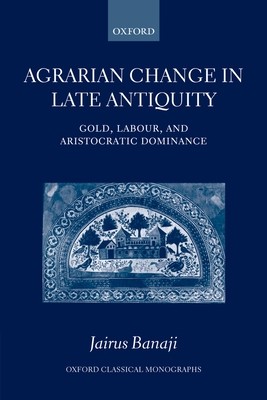
- We will send in 10–14 business days.
- Author: Jairus Banaji
- Publisher: Oxford University Press, USA
- ISBN-10: 0199226032
- ISBN-13: 9780199226030
- Format: 15.9 x 23.2 x 1.8 cm, kieti viršeliai
- Language: English
- SAVE -10% with code: EXTRA
Reviews
Description
The economy of the late antique Mediterranean is still largely seen through the prism of Weber's influential essay of 1896. Rejecting that orthodoxy, Jairus Banaji argues that the late empire saw substantial economic and social change, propelled by the powerful stimulus of a stable gold coinage that circulated widely. In successive chapters Banaji adduces fresh evidence for the prosperity of the late Roman countryside, the expanding circulation of gold, the restructuring of agrarian élites, and the extensive use of paid labour, above all in the period spanning the fifth to seventh centuries. The papyrological evidence is scrutinized in detail to show that a key development entailed the rise of a new aristocracy whose estates were immune to the devastating fragmentation of partible inheritance, extensively irrigated, and responsive to market opportunities. A concluding chapter defines the more general issue raised by the aristocracy's involvement in the monetary and business
economy of the period.
EXTRA 10 % discount with code: EXTRA
The promotion ends in 21d.07:52:49
The discount code is valid when purchasing from 10 €. Discounts do not stack.
- Author: Jairus Banaji
- Publisher: Oxford University Press, USA
- ISBN-10: 0199226032
- ISBN-13: 9780199226030
- Format: 15.9 x 23.2 x 1.8 cm, kieti viršeliai
- Language: English English
The economy of the late antique Mediterranean is still largely seen through the prism of Weber's influential essay of 1896. Rejecting that orthodoxy, Jairus Banaji argues that the late empire saw substantial economic and social change, propelled by the powerful stimulus of a stable gold coinage that circulated widely. In successive chapters Banaji adduces fresh evidence for the prosperity of the late Roman countryside, the expanding circulation of gold, the restructuring of agrarian élites, and the extensive use of paid labour, above all in the period spanning the fifth to seventh centuries. The papyrological evidence is scrutinized in detail to show that a key development entailed the rise of a new aristocracy whose estates were immune to the devastating fragmentation of partible inheritance, extensively irrigated, and responsive to market opportunities. A concluding chapter defines the more general issue raised by the aristocracy's involvement in the monetary and business
economy of the period.


Reviews